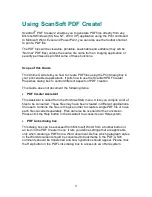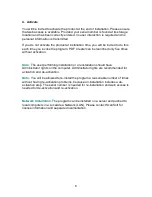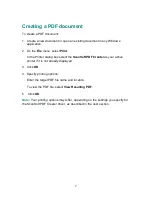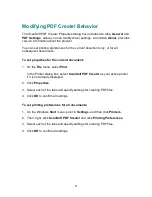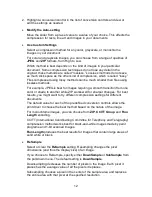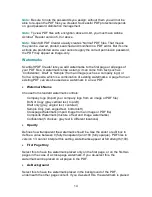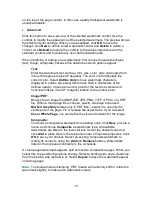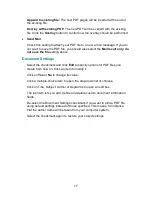
12
2. Highlight a conversion control in the list of conversion controls and view or
edit the settings as needed.
Modify the Auto-setting
Move the slider from a pre-set value to a value of your choice. This affects the
compression for texts, line art and images in your documents.
Use Custom Settings
Select a compression method for any color, grayscale, or monochrome
images in your document.
For color and grayscale images, you can choose from a range of qualities of
JPEG
and
ZIP
formats, from High to Low.
Which method is best depends on the kind of images in your particular
document. Some compression techniques do not lose any detail in the
or
i
gi
nal
:
t
hese
met
hods
ar
e
cal
l
ed
“
l
ossl
ess.
”
Lossl
ess
met
hods
do not save
as
much
di
sk
space
as
t
he
ot
her
ki
nd
of
compr
essi
on,
whi
ch
i
s
cal
l
ed
“
l
ossy.
”
Files compressed using lossy methods can be much smaller than files using
lossless methods.
For example, JPEG is best for images requiring a smooth transition from one
color or shade to another while ZIP works well for sharper changes. For best
results, you might want to try different compression settings for different
documents.
The default value for each of the predefined conversion controls allows the
print driver to choose the best method based on the nature of the image.
For monochrome images, you can choose from
ZIP
,
CCITT Group
and
Run
Length
encoding.
CCITT (International Coordinating Committee for Telephony and Telegraphy)
compression method works best for black-and-white images made by paint
programs and 1-bit scanned images.
Run Length
produces the best results for images that contain large areas of
solid white or black.
ReSample
Select or clear the
ReSample
setting. Resampling changes the pixel
dimensions (and thus the display size) of an image.
If you choose to ReSample, specify either
DownSample
or
SubSample
from
the pull-down menu. The default setting is
DownSample
.
Downsampling decreases the number of pixels in the image. Each pixel it
places has the average value of all the pixels it replaces.
Subsampling chooses a pixel in the center of the sample area and replaces
the entire area with that pixel at the specified resolution.



